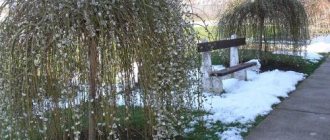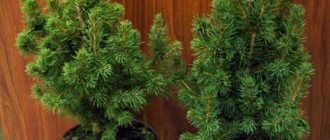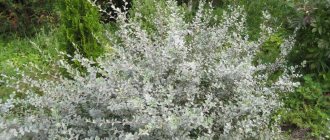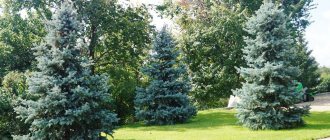It is necessary to have information about how walnuts grow in order to maintain this exotic crop in the garden or at home.
By following a number of agrotechnical recommendations, it is possible to get a good harvest of this healthy and tasty delicacy in your own garden. The process of planting and growing is within the capabilities of any gardener.
How to plant a nut
This culture prefers southern territories with a warm and mild climate. Walnut plantings in Russia can be found in the European part from Transcaucasia to the Leningrad region.
It is also found in more northern regions, but rather sporadically, since the plant is not particularly frost-resistant. It tolerates temperatures not lower than -20°C; in severe frosts the tree dies.
Planting a nut at home is not difficult, but you will need to follow a few simple rules.
This is a fairly large tree, sometimes reaching 25 - 30 m in height, and its girth can be more than 2.5 m.
Its root system is extremely powerful and branched, its diameter sometimes exceeds 15 - 20 m. It must be borne in mind that nothing will grow under such an extensive crown.
When several plants are cultivated, the nut planting scheme suggests that the distances between neighboring specimens should not be less than 10 m. It is best to plant trees one at a time, because the harvest is richer on single trees.
In the southern regions it can be planted in spring or autumn. In the northern regions, spring planting is preferable, because in the fall the seedling will not have time to take root properly and will freeze.
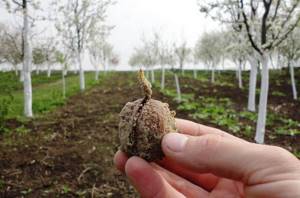
Walnuts should be planted on the site in a place chosen in advance. It should be as sunny as possible, because this crop will not grow in the shade.
The furthest place on the edge of the territory, where the tree will not interfere with other garden and vegetable plants, is best suited.
Any soil is suitable for walnuts. The main thing is that there is a good layer of drainage. The plant does not tolerate close groundwater.
It is recommended to prepare a planting hole with a diameter of about 1 m in the fall. Its depth should be 25 - 30 cm greater than the length of the root system.
Fertile soil is mixed with peat and humus in equal parts, then superphosphate (2.5 - 3 kg), lime flour (0.5 - 1 kg), and potassium chloride (0.8 kg) are added. Fill the hole with the prepared soil mixture and leave it until spring.
With the onset of warm weather, the walnut seedling is placed on the prepared area. The roots are pre-treated with any growth stimulant and coated with clay mash.
The root collar should not be below ground level. The soil in the tree trunk circle is well trampled down, watered abundantly, and then mulched with peat, straw or humus.
general information
More than a thousand years ago, this tree arrived in Europe from Central Asia. It was brought to Russia by Greek merchants, which was the reason why the plant received such a name. Now it is being bred not only in hot countries of the world, but also in Russia, Moldova, Belarus, as well as in Ukraine and the Caucasus.
In ancient times, walnuts had several other names : “food of heroes”, “acorn of the gods”, “tree of life”. From time immemorial, people have respected and loved this powerful plant, because it gave them tasty and very healthy fruits. Other parts of the tree were also actively used, for example, the foliage was used for medicinal purposes.
The walnut is not only one of the largest, but also one of the longest-living species among all trees in the Middle Zone. Based on statistical data, we can say with confidence that some specimens lived up to 400–600 years. However, today the likelihood of meeting such a long-liver is extremely low, because walnut wood is highly valued and is actively used for the production of expensive luxury furniture and decorative elements.
According to experienced gardeners, the number of fruits that can be obtained from one tree primarily depends on the age of the plant. Thus, the yield of a young (up to 50 years old) walnut is not comparable to that which has managed to cross the hundred-year mark.
Description and characteristics
This walnut tree is considered tall. If the plant likes the place that is allocated to it on the site, and the gardener follows all the prescribed rules for caring for it, then the walnut can grow up to 18-23 meters in height.
Read also: Christmas tree from origami modules step by step instructions
The spreading crown of the tree can reach 15 meters in diameter, and the branches diverge at right angles. It should be concluded: before planting such a plant in your garden, you should take a responsible approach to choosing a location so that the grown tree does not spoil the appearance of the site, does not touch the buildings with branches and does not block sunlight from other plantings.
The walnut tree has a very powerful and branched root system . During the first three years, the main tap root develops; as it grows, it tends to penetrate into the very depths of the soil and gain a foothold in it. At 4-6 years of life of the tree, lateral roots are formed, they diverge 5-6 meters in different directions from the main one.
Such roots are located close to the soil surface, but only 30-50 centimeters deep. This perfect root system helps the adult plant not to suffer from low rainfall and insufficient watering, since the large capture area allows it to independently find water.
If you cut down an adult walnut tree, but do not touch the stump that remains from it, then after a while young shoots will begin to grow from the stump, from which in 1-2 years it will be possible to harvest the first harvest. Take this feature into account if you want to get rid of the tree forever, because in this case it is not enough to simply cut it down, you will have to uproot the stump. There is no need to worry about the roots remaining in the ground - they are not capable of producing new shoots.
This nut blooms in spring (April-May) and lasts about 2-3 weeks. Flowers bloom at the very beginning of the growing season, without waiting for all the leaves to form. At the tips of annual shoots, female flowers are formed, on the remaining branches - male flowers, which come together in 5-10 pieces and form earrings.
In the climatic conditions of the middle and southern zone, repeated flowering can be seen, usually in mid-June. The walnut tree is a self-pollinating plant; the fruits ripen in mid-autumn (September-October). It is worth noting that nuts from different trees often differ in size and taste.
Varieties for the middle zone
Today, Russian gardeners choose one of 20-25 hybrid varieties to grow walnut trees in the climatic conditions of the middle zone. These varieties were bred specifically for our regions; they are characterized by high yields and resistance to low temperatures.
The following varietal species are most suitable for Russian garden plots:
- “Harvest” - distinguished by a high oval-shaped crown and spreading branches. It is very frost-resistant, so it has been successfully grown in the middle zone for a long time. Another positive quality of the variety is considered to be an early harvest - it can be harvested already in early autumn, before the weather gets colder and the rains begin. Resistant to most insect pests and diseases that affect walnut bushes and trees.
- "Dessert". The variety is suitable for growing in hot regions, as it is resistant to drought, but does not tolerate cold weather (due to low temperatures, the buds and bark crack). It is quite miniature (up to 3 meters in height), but has a dense crown, suitable for small summer cottages. From a tree of this variety you can get a good harvest - 20-27 kilograms of nuts per season.
- "Abundant." It grows up to 5 meters, produces the first harvest 4-5 years after planting. From one tree you can get up to 30 kilograms of nuts per year. They grow in clusters of 8-10 fruits. It is recommended to avoid this variety if you live in the northern regions, since “Izobilny” is not resistant to frost and cold winters. It has high immunity to diseases such as fusarium and brown spot. Gardeners note the excellent taste of the fruits of this variety.
- “In Memory of Minova” is the most popular variety in our country. It gained recognition among gardeners due to the early ripening of its fruits. The tree produces its first harvest 5-6 years after planting. The nuts are flattened, large, the shell is thin, and has a silvery tint.
- “Graceful” is a massive plant up to 5 meters high. It has a dense crown, resistance to diseases, frost, and insect pests. It bears fruit in mid-autumn; the first harvest can be expected in the fifth year after planting. The average yield is 20 kilograms of nuts per season.
- "Black Walnut" It got its name because of the large fruits in a hard and thick black peel. The tree grows very tall and produces its first harvest only in the 10th year of its life. Loves sunlight and moist soils. In winter, young plants need additional shelter; mature specimens tolerate low temperatures well.
- “Ideal” is a fast-growing variety that produces the first harvest 3-4 years after planting. When a tree reaches 12 years of age, its productivity increases to 120 kilograms of nuts per season. It is recommended to plant away from buildings, as it has a highly branched root system that develops a large area of land around it. This plant requires good lighting; it prefers loamy soils of medium humidity.
Read also: Flowers for prosperity and happiness in the home

Reproduction
There are two ways to grow walnuts with your own hands: seed and vegetative (grafting).
How to grow a walnut from a nut
It is extremely important to choose the right planting material for seed propagation. Only fresh seeds have good germination.
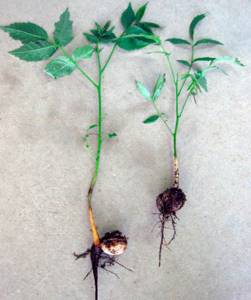
If the future plant is planned to be kept in an apartment, then any variety will do.
If it is intended to grow on a personal plot, then to grow walnuts from walnuts it is better to take material from trees growing in the area.
In autumn, the seeds are planted directly into the ground on the site. The soil mixture is prepared from humus, peat and turf soil, taken in equal parts.
The fruits are laid out in holes at a distance of 10-15 cm between each other and at a distance of 50 cm between rows.
The embedding depth varies from 5 to 12 cm. Larger nuts are embedded deeper.
Then the plantings are covered with soil mixture, well watered and covered with a layer of fallen leaves or straw.
Another time when you can plant a walnut from a fruit is spring. But before this, the planting material must undergo stratification.
To do this, the seeds are placed in a container with wet coarse sand, then stored for 2 - 3 months in a cool room (cellar, basement, refrigerator) at a temperature of 0...+8°C.
At this time, it is necessary to monitor the moisture content of the sand and water it periodically. In the spring, the sprouted seeds are planted in the ground or in a pot according to the same scheme as in the fall.
Seedlings that have produced 2 pairs of leaves are transplanted into a schoolhouse. After 2 years, young trees will be ready to be transplanted to a permanent location.
Walnut grafting in spring
The vegetative method is considered more acceptable, since it better conveys varietal characteristics. Young seedlings are grafted using the budding method.
A bud with a piece of bark in the form of a half-tube is cut from the scion with a special knife.
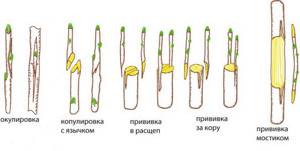
A similar cut is made on the rootstock, where the rootstock shield is inserted. Then the work site is wrapped with electrical tape, leaving the peephole open. After 15 - 20 days, the bandage is removed.
The buds can freeze in winter, so in the middle zone it is recommended to dig up grafted seedlings in the fall and store them in the basement or cellar until spring.
Starting a plantation by sowing - growing a tree from a nut
The methods of cultivating the plant in different regions are practically the same, but still, in the southern regions, the mild climate makes it possible to simplify the planting process. For example, you can plant walnuts in the south of the country both in early spring and in autumn. In the middle zone, landing should be started only with the onset of stable warm weather. Because as a result of autumn planting, seedlings may not withstand severe frosts.
The long growing season of some varieties determines the location of cultivation exclusively in areas with a warm climate. Only early-ripening and frost-resistant varieties are capable of full development and fruiting in mid-latitudes. Be that as it may, proper care and adherence to the correct technologies will help gardeners reap an excellent harvest of nuts even in the central and northern regions.

Walnuts grow well in illuminated flat areas or in places that are located in the middle part of the hill. In this case, the planting plot should be protected as much as possible from strong winds. An additional shelter from drafts can be the wall of some building located nearby.
Neighborhood with natural or artificial shelters increases the ambient temperature by 3–4 degrees. But remember that you should not plant the plant close to a living space. In the future, the root system of this giant will damage the foundation.
Fruit and berry crops easily tolerate proximity to nuts. They age and stop producing fruits even before the nut reaches an impressive size. The huge crown becomes a barrier to the penetration of the sun's rays, so do not plant flowers nearby.
Note! The tree's foliage contains juglones, which are toxic to most plants.
Start choosing seeds for growing in advance. Stock up on seeding material in the fall, as it is easier to purchase freshly harvested nuts at this time. Select the largest, ripest and most undamaged specimens from them. Do not use fried and dried specimens; it is impossible to grow a tree from them.
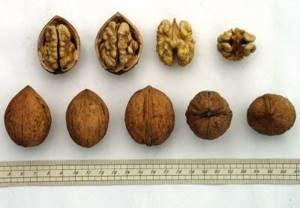
We carry out pre-sowing preparation in the following order:
- Place the seeds flat in a container of a suitable size (container, box).
- Cover the nuts with wet sand.
- We put the vessel in a cool place where the air temperature ranges from 0 to +5 degrees (cellar, basement, bottom shelf of the refrigerator). The stratification period takes 3–4 months.
- Several times a month we take out the container with the seedlings, ventilate them and moisten the sand.
After the specified period, we remove the workpieces and plant them in the ground. The most favorable month for planting nut fruits is April. To begin with, select a large pot or tub. Then we prepare a fertile substrate: mix peat, turf soil and humus in equal proportions.
We carry out subsequent work in the following sequence:
- fill the container for planting 1/3 with drainage;
- pour the prepared soil mixture on top;
- we plant the fruits 7–8 cm deep with the end part downwards;
- water the soil;
- We leave the crops in a warm, bright place; you can cover them with glass or transparent film.
Shoots will appear after 10–12 days. Their development depends on our competent actions, because caring for young shoots has its own characteristics. We do not allow the earthen clod to dry out under any circumstances. A young seedling is more likely to tolerate excess moisture than drought.

During the warm season, we take the nut out into the fresh air in a secluded sunny place. In hot weather, wrap the pot in which the nut is planted with a damp cloth or place it in cool water. This way we can avoid overheating the roots.
Every year we update the mulch under the seedling. Moss, rotted organic matter or peat need to be changed. It will be useful to use complex potash fertilizers as a fertilizer. We apply these substances throughout the growing season, once every 14 days.
We regularly check the tree for diseases and infections. The plant can be affected by pests such as codling moths, aphids, and American white butterflies. The greatest danger to this crop is caused by diseases such as root canker, bacteriosis, and fire blight.
A year after sowing, we transplant the shoots. Walnuts grown using this method begin to bear fruit after 5–7 years.
What year does a walnut bear fruit?
The time when a nut tree begins to bear fruit depends on its varietal. Early-growing varieties are capable of producing a small harvest for 3-4 years.
From large-fruited varieties, fruits should not be expected earlier than 10 - 12 years.
But sometimes a walnut that is already quite mature does not bear fruit. The reasons for the lack of fruiting may be different:
- plants grown from seeds bear fruit much later;
- there were difficulties with pollination (not all varieties are self-pollinating);
- pollen does not ripen due to prolonged rains;
- errors during planting (the seedling is too deep);
- presence of diseases.
Walnut care
Mature walnut trees require virtually no maintenance.
For the correct formation of the root system, young trees need special attention, which consists of regular watering, timely pruning and periodic feeding.
in spring
In spring, when walnuts are expected to bloom, the plants need careful care. Before the movement of juices and swelling of the buds begins, sanitary pruning is carried out, during which all dry and damaged branches are removed.
The skeletal branches and the lower part of the trunk are cleaned of old dead bark, then washed with a 3% solution of copper sulfate. It is necessary to whiten the stem with fresh lime.
During this period, a planned replanting of walnuts is carried out, and for preventive purposes, the trees are treated with drugs against pests and diseases.
In May, plants are fed with ammonium nitrate (6 kg per adult tree).
In summer
Summer care involves regular watering, especially in dry and hot weather. From May to July, it is recommended to water walnuts once every 2 weeks. Young seedlings need to be moistened more often.
All weeds should be removed, but there is no need to loosen the soil in the tree trunk circle, since the plant does not tolerate this.
In summer it is necessary to apply potassium phosphate fertilizers and fertilizing with microelements. They are fed mainly by foliar feeding.
Regular inspections of trees are carried out in order to detect pests and diseases that may affect the crop in the summer. If a danger is detected, treatment with special preparations is carried out.
in autumn
After harvesting and falling leaves, sanitary pruning is carried out, fallen leaves and debris are raked, and the whitewashing of the lower trunk and skeletal branches is renewed.
You can replant a walnut, but as a last resort, since the plant will be weakened and the risk of it freezing increases. Young seedlings need to be prepared for the winter.
It is necessary to treat trees from insect pests and spores of fungal diseases that can be found in the bark, as well as in the soil.
They can become the reason why a walnut does not bear fruit. Spraying is carried out with copper sulfate or Bordeaux mixture.
Walnut wintering
It is not possible to insulate mature trees, and they spend the winter without shelter. Annual plants and young seedlings need protection and are wrapped in burlap or canvas.
The tree trunk circle is mulched with manure or humus, but you need to step back about 10 cm from the trunk.
How to properly germinate walnuts
To get the most benefit from your sprout, it is important to follow the sprouting procedure correctly. Otherwise, you can simply ruin the fruits
The nuts may not open or turn sour.
- To obtain sprouts, only fresh products that are not subject to heat treatment are suitable.
- The nuts are washed thoroughly, preferably in running water. Dust and dirt are washed away.
- Place in shells in a flat-bottomed container and fill with clean water.
- To get results, the nuts must be kept in water for two weeks. During this period, you need to mix the fruits twice a day. Drain the water every other day, and if necessary, every day. If the water smells unpleasant and begins to “stretch”, it is better to change it every day.
- After three days, inspect, if any fruits do not sprout, they can be thrown away. These won't germinate.
It is recommended to use for a month. Three fruits in the morning and evening. Rapid germination is possible using the same scheme. Just drain the nuts after 3 days. It will be possible to eat the fruits, but they will not yet gain full strength.
When and how to prune a tree
Pruning is an important step in nut tree care. Only young trees that have reached 1.5 m in height need crown formation.
Using a sharp pruner, all unnecessary branches are removed, leaving about 10 main branches of the skeleton, all shoots are cut to 15 - 20 cm.
The growth from the trunk must be constantly removed. After 3 - 4 years, the crown of the nut will be formed, and in the future only trimmings will be needed for sanitary purposes.
Spring pruning
In spring, all dried, damaged and frozen shoots are pruned. Branches that cross, bend down, or point inward are removed.
It is recommended to prune branches at the same time as formative pruning.
Walnut pruning in autumn
At the end of leaf fall, diseased, broken and drying shoots are pruned.
It is also necessary to get rid of branches that are growing incorrectly so that they do not take away the juices from the plant.
Planting and subsequent care of seedlings
Planting walnuts in open ground
Regardless of whether the seedlings were purchased or sprouted at home, the most optimal time for planting them on the site is May. At the end of spring, there is no longer a risk of night frosts, and the tree will have sufficient time to adapt to new conditions and comprehensively prepare for its first wintering.
Initially, you will need to prepare the landing site as follows:
- The selected area must be completely cleared, all weeds, roots, stones, debris and other unwanted elements are removed from it.
- The hole, the size of which should be 60x60 cm, is dug directly on the day of planting, since otherwise there will not be enough moisture in it. Additional artificial hydration is strictly prohibited.
- The planting site must be fertilized, this is especially true for areas with low soil fertility. To do this, it is recommended to mix manure with superphosphate in a bucket and add a few glasses of wood ash. The pit is further deepened by another 80 cm, after which the prepared mixture is added to it.
After completing all preparatory activities, you can proceed directly to the planting process, which will look like this:
Before planting, the seedling must be subjected to an external inspection: all dry shoots or diseased roots found must be cut off.
The lateral roots are straightened in such a way that they take a horizontal position
This must be done extremely carefully and carefully so as not to break them.
The seedling is placed in a prepared hole, after which one person must hold it and the other must sprinkle the roots with soil. You need to start with the processes located at the very bottom, gradually rising higher.
The tree should be positioned so that the uppermost shoots of the root system are buried by 5–7 cm.
Planting depth always depends on the size of the root system, but its value cannot be less than 70 cm
It is recommended to dig holes so that their depth is 30–40 cm greater than the longest root shoots.
Aftercare
The planting of the seedlings has been completed, but now they need some care, which will allow the tree to get stronger and get used to new conditions as quickly as possible. To do this you will need to do the following:
- Water the walnut generously; at first, each seedling requires a large amount of moisture, so at least 15–20 liters should be poured under the root. You can begin this procedure 2–3 weeks after planting the tree.
- Mulching the soil around the seedling is a mandatory procedure, which allows you to avoid possible drying out and subsequent cracking of its surface. It is recommended to use straw, peat chips or fairly dry sawdust; the optimal layer thickness is 2–3 cm.
- Organization of the embankment around the planted tree, it should consist of earth and humus, while the first component is required three times more. Taking such measures will allow you to collect rainwater necessary to feed the root system. The embankment can be located at a distance of 30 to 50 cm from the trunk.
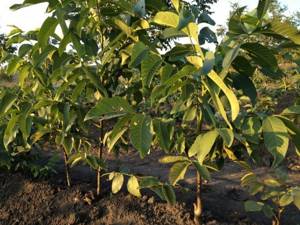
Diseases and pests
This crop is rarely affected by diseases and pests. But some mistakes in care can lead to plant disease. It is necessary to consider the most dangerous walnut diseases and their treatment:

- Brown spot. It is the most dangerous nut disease.
Dark brown spots appear on leaf blades, ovaries and branches. The fruits become ulcerated and rot. Ruthless removal and destruction of all damaged shoots and leaves is required.
To combat the fungus, spray with fungicides (Strobi, Vectra) or 1% Bordeaux mixture (3 times per season).
- Bacteriosis. Dark spots appear on the leaves, then they become deformed and fly off.
The fruits fall off before they ripen. For preventive and therapeutic purposes, treatments are carried out with Bordeaux mixture or copper sulfate. In the fall, it is necessary to collect and burn all the foliage.
- Root cancer. The infection affects the roots, as a result of which the tree does not grow and may not bear fruit at all.
Growths on the roots and bark should be cut off, the wounds should be treated with caustic soda (1% solution) and rinsed well with water.
Of the insect pests, this crop is most often affected by the codling moth, warty mite, nut moth, American white butterfly, etc.
To destroy them, insecticidal and acaricidal preparations are used (Aktara, Confidor, Aktellik, etc.).
Names and types of nuts
Walnut varieties have been bred by breeders in large quantities. There are varieties that are resistant to diseases and pests, can withstand fairly severe frosts, have thin and easily cracked shells, etc.
The following varieties are considered the most popular among gardeners:
- Giant. Large fruits weighing up to 9 - 10 g. Grown throughout Russian territory.
- Elegant. The variety is resistant to lack of moisture, as well as diseases and pests. Due to its average frost resistance, it is cultivated in the southern and central regions.
- Ideal. The main characteristic of the Ideal walnut is its exceptional frost resistance. It can withstand frosts down to -35°C and produces 2 harvests per season. Fruits weighing from 10 to 15 g.
- Dawn of the East. A low tree with early ripening and frost resistance.
- Breeder. The fruits have a thin shell, but are not large (up to 7 g).
- Dessert. Drought-resistant and early variety, grown only in warm areas.
Growing a walnut at first involves some difficulties, but then the tree will delight you with tasty and unusually healthy fruits.
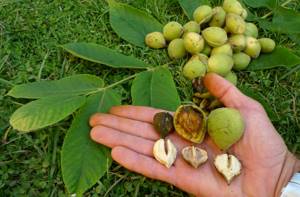
CherryLink plugin not found
BLACK WALNUT - PLANTING AND CARE
Black walnut (Juglans nigra L.) is the largest tree of the Juglans genus, which includes walnut. In its homeland, in the forested areas of the eastern part of the United States, it reaches 30-50 m in height. The leaves have a sharp aromatic and balsamic odor, characteristic of black walnut.

The tree is quite resistant to dry conditions due to its spreading, low-lying crown. This variety of nut trees is a powerful air purifier from dust and harmful inclusions. The crown produces a huge amount of useful phytoncides and tannins. Walnut fruits are considered a very valuable raw material for many applications, especially for pharmacology.
The kernel of the nut is very tasty, has a special aroma, contains 60% high-quality oil, 30% high-value proteins (almost twice as much as walnuts), 6% carbohydrates. In the USA, the nut kernel is a valuable aromatic food.
Fruits in milky-waxy ripeness are an excellent raw material for the production of fortified jam, which in terms of vitamin C content is 1.5-2.6 times higher than walnut jam with almost the same content of other food components.
Green leaves, pericarps, green fruits and other parts of the plant are the most valuable medicinal raw materials. Due to their rich biochemical composition, preparations based on them are used as biological additives. Oil from black walnut fruits is highly valued, as it has great resistance to oxidation (does not go bitter), so it is indispensable for confectionery products and is used in the cosmetic and pharmaceutical industries. Due to its unique nutritional qualities, black walnut oil is recognized as a product of the 21st century.
Black walnut is propagated by seeds, cuttings and grafting. For those who want to successfully grow nut crops on their plots, it is necessary to know some of the specific requirements that these wonderful plants impose. Attitude to light. Light-loving, low-shade-tolerant breed. Black walnut is considered more shade-tolerant than gray walnut, but less than walnut. Attitude to heat. Moderately demanding of heat. It is believed that for normal growth and development it needs a sum of active temperatures (from 10C and above) of at least 2200-2400C. However, fruit-bearing black walnut trees are found up to the latitude of St. Petersburg inclusive. In the conditions of Tula, a fruit-bearing black walnut tree turned out to be more winter-hardy than Manchurian and walnuts, withstanding -38C in the air (2003, 2006), and the root system -17C at a depth of 3 cm (2003).
During the first three years of life, black walnut is susceptible to damage by spring frosts, even in its homeland. When the crown leaves the ground zone, it is not afraid of frost. In autumn, the green organs of the plant are more resistant to frost than those of the walnut.
Attitude to moisture. In terms of drought resistance, it occupies an intermediate position between walnut and Manchurian nut. It is believed that black walnut is suitable for crops in floodplains. In the floodplain of the river. Kuban black walnut successfully withstands short-term flooding, and in its homeland, in North America, when growing in floodplains, black walnut can withstand flooding lasting 1-1.5 months.
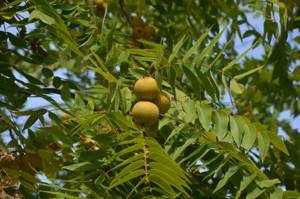
The seeds are suitable for planting. It is better to plant them in autumn or spring. It is better to use seeds from previous harvests, after soaking them for several days in warm water. You need to make a furrow in which the seeds will be sown. The depth should be 8 centimeters. Practice has shown that it is better to plant nuts in the fall, because... seedlings are more viable and strong. If planting in spring, early May is best. Seeds need to be germinated before planting. Towards the end of January, the seeds are planted in small containers filled with peat with the addition of wet river sand. After this, the seeds are removed to a room where the air temperature does not exceed 7 degrees. Select in advance the area where the tree will grow, since germinated seeds are planted in a permanent place. It is desirable that this area has protection from the wind and is sufficiently well lit. The distance between seeds should not be less than 75 centimeters. Close up, lay the seeds on their sides, and then level the soil on top and start watering. Within two weeks the first shoots should appear.
After sifting, throughout the year, the plants need to be looked after regularly. It is necessary to promptly remove all weeds, loosen the soil and ensure periodic watering. You can plant sunflowers or corn between the rows so that young nut seedlings are not damaged by wind or snow in winter.
Planting a YOUNG TREE. Planting holes are dug in such a way that the roots of the tree are placed in it freely and there is space for their growth in all directions. Humus, wood ash or phosphorus-potassium fertilizers are added to the pit. In order to retain moisture longer after watering, the root system of the seedling is covered 4/5 with soil in the hole and watered abundantly. The water is absorbed within 5-7 minutes, after which the remaining part of the soil is filled in and the tree trunk circle is mulched.
For better survival of a plant in a new place, its correct placement relative to the cardinal directions is of great importance. The more “tanned” part of the stem and shoots should face south (corresponding to the original place of growth of the plant). Proper planting reduces the time it takes for a plant to adapt to a new location.
Place and soil. Walnut plants do not like acidic soil, which is genetically inherent in them; they prefer a neutral or slightly alkaline environment. On such soil, they finish growing in a timely manner, are well prepared for winter and better tolerate low winter temperatures. When planting in non-Black Earth conditions, this can be achieved by adding wood ash, phosphorus-potassium fertilizers (doses and rates depend on the soil) into the planting hole, and then adding lime fertilizers to the tree trunk area to maintain a pH of 6.5-7.5. If there is an excess of nitrogen in the soil, the plant retards growth, the wood does not ripen well and freezes in winter.
Walnut trees need protection from north and northeast winds. Protection can be buildings and other more winter-hardy trees. Much depends on the microrelief of the site. As a winter-hardy species, black walnut can be placed on the northern and northeastern sides of the site, which should be moderately ventilated, at a distance of 5-6 m from existing buildings and 8-10 m between trees. The plant does not like low-lying places with stagnant air.
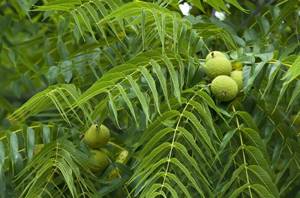
Care. Walnut trees need a sufficient amount of moisture in the first half of the growing season (the period of growth and flowering) and its reduction in the second half of summer for the timely completion of growth, ripening of wood and preparation for winter. In fruitful years and during dry summers, watering is necessary. For black walnuts at the time of fruiting, sufficient moisture is necessary during the period of fruit filling - July - mid-August.
For good plant growth, the soil must be loose and mulched (especially for early-bearing forms of nuts). In the second half of summer, loosening is stopped to avoid delaying growth processes.
Trimming and shaping. Usually a tree forms itself. Dried branches, as well as those that thicken the crown and poorly placed branches are cut out. The best time for pruning in central Russia is spring, when the threat of severe frosts (below -10C) has passed. Ideal pruning after buds open and growth begins (less juice leakage), but this is not always convenient. Shortening pruning of trees should not be carried out until mid-August, as this can provoke the awakening of buds and re-growth, which in our conditions will lead to freezing of sprouted shoots in winter.
Neighboring plants. The root system is deep, tap-type with powerful lateral branches and anchor roots. It is known that black walnut roots emit toxins that poison alfalfa, tomatoes, potatoes, apple trees, pine trees, black currants and birch trees when grown closely together.
The best accompanying tree species for black walnut are linden (small-leaved, etc.), maples (with the exception of ash-leaved and silver), hornbeam, common pear, forest apple, and cherry plum. Among the shrubs - dogwood, cotoneaster, viburnum, hazel, Tatarian honeysuckle, black and red elderberry, Japanese quince, Tatarian maple, sowberry, golden currant, etc. E.A. Vasin, Candidate of Agricultural Sciences








